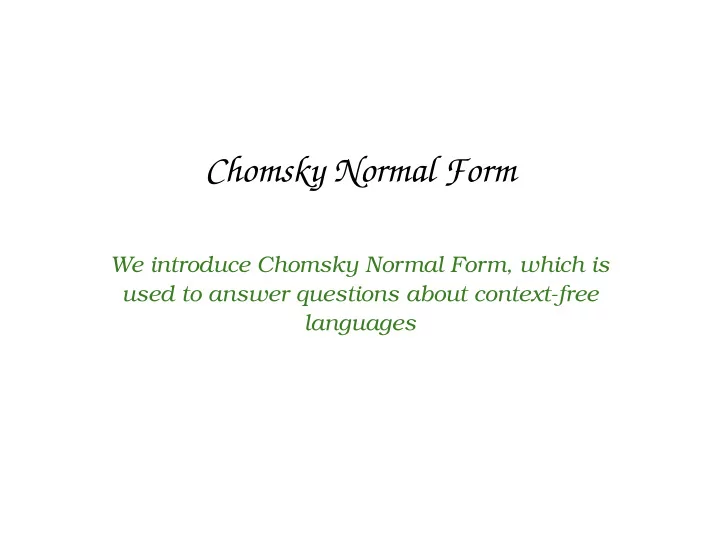

Chomsky Normal Form We introduce Chomsky Normal Form, which is used to answer questions about context-free languages
Chomsky Normal Form A grammar where Chomsky Normal Form. every production is either of the form A → BC or A → c (where A , B , C are arbitrary variables and c an arbitrary symbol). Example: S → AS | a A → SA | b (If language contains ε , then we allow S → ε where S is start symbol, and forbid S on RHS.) Goddard 9a: 2
Why Chomsky Normal Form? The key advantage is that in Chomsky Normal Form, every derivation of a string of n letters has exactly 2 n − 1 steps. Thus: one can determine if a string is in the lan- guage by exhaustive search of all derivations. Goddard 9a: 3
Conversion The conversion to Chomsky Normal Form has four main steps: 1. Get rid of all ε productions. 2. Get rid of all productions where RHS is one variable. 3. Replace every production that is too long by shorter productions. 4. Move all terminals to productions where RHS is one terminal. Goddard 9a: 4
1) Eliminate ε Productions Determine the nullable variables (those that gen- erate ε ) (algorithm given earlier). Go through all productions, and for each, omit every possible subset of nullable variables. For example, if P → A x B with both A and B nullable, add productions P → x B | A x | x . After this, delete all productions with empty RHS. Goddard 9a: 5
2) Eliminate Variable Unit Productions A unit production is where RHS has only one symbol. Consider production A → B . Then for every pro- duction B → α , add the production A → α . Re- peat until done (but don’t re-create a unit pro- duction already deleted). Goddard 9a: 6
3) Replace Long Productions by Shorter Ones For example, if have production A → BCD , then replace it with A → BE and E → CD . (In theory this introduces many new variables, but one can re-use variables if careful.) Goddard 9a: 7
4) Move Terminals to Unit Productions For every terminal on the right of a non-unit production, add a substitute variable. For example, replace production A → b C with productions A → BC and B → b . Goddard 9a: 8
Example Consider the CFG: S → a X b X X → a Y | b Y | ε Y → X | c The variable X is nullable; and so therefore is Y . After elimination of ε , we obtain: S → a X b X | ab X | a X b | ab X → a Y | b Y | a | b Y → X | c Goddard 9a: 9
Example: Step 2 After elimination of the unit production Y → X , we obtain: S → a X b X | ab X | a X b | ab X → a Y | b Y | a | b Y → a Y | b Y | a | b | c Goddard 9a: 10
Example: Steps 3 & 4 Now, break up the RHSs of S ; and replace a by A , b by B and c by C wherever not units: S → EF | AF | EB | AB X → AY | BY | a | b Y → AY | BY | a | b | c E → AX F → BX A → a B → b C → c Goddard 9a: 11
Practice Convert the following CFG into Chomsky Nor- mal Form: S → A b A A → A a | ε Goddard 9a: 12
Solution to Practice After the first step, one has: S → A b A | b A | A b | b A → A a | a The second step does not apply. After the third step, one has: S → TA | b A | A b | b A → A a | a T → A b Goddard 9a: 13
Solution Continued And finally, one has: S → TA | BA | AB | b A → AC | a T → AB B → b C → a Goddard 9a: 14
Summary There are special forms for CFGs such as Chom- sky Normal Form, where every production has the form A → BC or A → c . The algorithm to convert to this form involves (1) determin- ing all nullable variables and getting rid of all ε -productions, (2) getting rid of all variable unit productions, (3) breaking up long productions, and (4) moving terminals to unit productions. Goddard 9a: 15
Recommend
More recommend